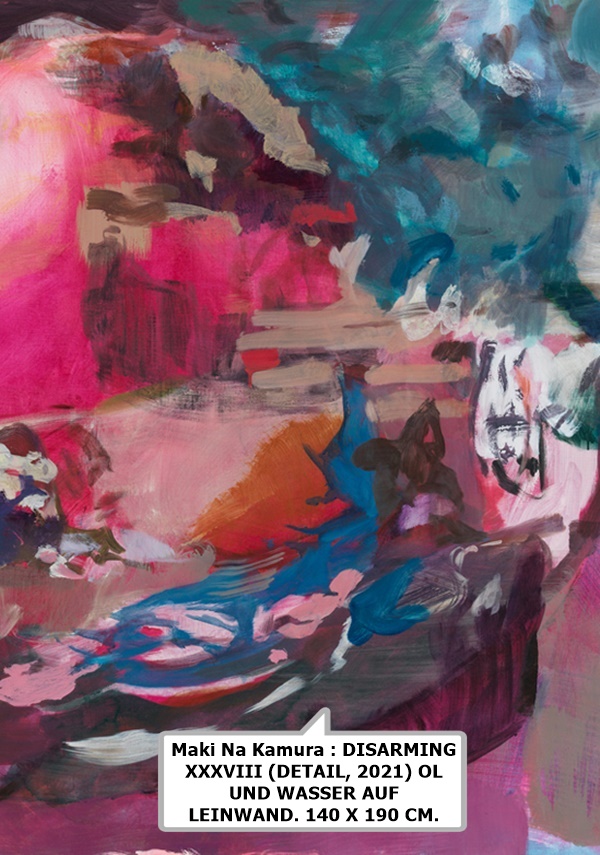"B-DU DU - VISUAL IDIOM OF THE INCONGROUS AND THE UNLITERARY"
Maki Na Kamura

Contemporary Fine Arts Galerie
Grolmanstraße 32/33 10623 Berlin GermanyTELEPHONE +49-30-288 787 0 FAX +49-30-288 787 26 e-mail:



29 April > 5 June, 2021

B-DU DU—a nonsensical string of letters, a title that amounts to a gibberish of sorts—is typical for Maki Na Kamuras understanding of painting. It’s something she assigns her own meaning to, as here she deems it a visual idiom for the incongruous and the unliterary. This is an assertion, just as her paintings are.
Where Na Kamura paraphrases apparently ideal painted landscapes, she does so only under the premise that the image should say nothing, proclaim no higher truth. It cannot (or should not or will not) have any meaning beyond itself. It exists, rather, as an image. If she alludes to Giorgione’s Sleeping Venus (1510), for instance, she is uninterested in the painting as something sensual, conducting rather an abstract dissolution of the image, which critic Robert Fleck described „as an empty space and a void in the picture’s center.“ If Na Kamura evokes Jean-François Millet’s The Gleaners (1857), which she studied extensively, learning also that Millet had not painted his peasant women from life, but rather availed them from Poussin, it is in a spiraled motion through which Na Kamura channels Millet’s gesture.
But art history is no treasure trove of reference points for Na Kamura. Her method is better described as dissecting than as quoting anyway. She investigates and breaks down the pictorial elements from the history of the medium, reducing them to gesture and structure. Motifs are liberated from their contexts. Like a bag of tricks, mean-ing and conceptual relationships become formal and gestural elements in paint on canvas.
While she turns to history of figurative painting, Na Kamuras oeuvre is more closely aligned with abstraction, though discerning a distinction or interaction between the two is of no interest to her. Over the past months in lockdown, Na Kamura has begun to look beyond art historical purview in a deep dive into K-Pop. She is fascinated by the cult phenomenon’s synchronized choreography, devised with military precision and immaculate aesthetics. Indeed, in every instance, each of the young Korean idols functions as an image of the group and stands out as an individual.
The visual material that filters into Na Kamuras paintings is wide-ranging. Her dissecting gaze remains curious and open. This mode of looking, of resituating, is reminiscent of Aby Warburg’s Mnemosyne Atlas which maps recurrent visual phenomena and patterns from antiquity through to the present day. While their motivation and output of course vary greatly, consider, for instance, Warburg’s pairing of ancient vases and contemporary advertising as analogous to Na Kamuras recent paintings that place meticulously coordinated dancing teenagers in idealized classical landscapes.
But let’s forget about all this. What really counts, what this artist is or intends or is interested in is above all the painting, not the path to it. To put it in her own words: „My hands can produce images without knowing why they do it. Painting is in itself an absurd act—its irrationality can be an asset for the future.“
Maki Na Kamura was born in Japan and lives and works in Berlin. Recent institutional exhibitions include the Oldenburger Kunstverein; Bilbao Arte – Centro de arte Contemporaneo, Bilbao; Museum Haus Kasuya, Yokosuka, Japan; Karl-Ernst-Osthaus-Museum, Hagen and Museum Dhondt-Dhaenens, Deurle, Belgium, among others. This is her second solo exhibition with the gallery.
Where Na Kamura paraphrases apparently ideal painted landscapes, she does so only under the premise that the image should say nothing, proclaim no higher truth. It cannot (or should not or will not) have any meaning beyond itself. It exists, rather, as an image. If she alludes to Giorgione’s Sleeping Venus (1510), for instance, she is uninterested in the painting as something sensual, conducting rather an abstract dissolution of the image, which critic Robert Fleck described „as an empty space and a void in the picture’s center.“ If Na Kamura evokes Jean-François Millet’s The Gleaners (1857), which she studied extensively, learning also that Millet had not painted his peasant women from life, but rather availed them from Poussin, it is in a spiraled motion through which Na Kamura channels Millet’s gesture.
But art history is no treasure trove of reference points for Na Kamura. Her method is better described as dissecting than as quoting anyway. She investigates and breaks down the pictorial elements from the history of the medium, reducing them to gesture and structure. Motifs are liberated from their contexts. Like a bag of tricks, mean-ing and conceptual relationships become formal and gestural elements in paint on canvas.
While she turns to history of figurative painting, Na Kamuras oeuvre is more closely aligned with abstraction, though discerning a distinction or interaction between the two is of no interest to her. Over the past months in lockdown, Na Kamura has begun to look beyond art historical purview in a deep dive into K-Pop. She is fascinated by the cult phenomenon’s synchronized choreography, devised with military precision and immaculate aesthetics. Indeed, in every instance, each of the young Korean idols functions as an image of the group and stands out as an individual.
The visual material that filters into Na Kamuras paintings is wide-ranging. Her dissecting gaze remains curious and open. This mode of looking, of resituating, is reminiscent of Aby Warburg’s Mnemosyne Atlas which maps recurrent visual phenomena and patterns from antiquity through to the present day. While their motivation and output of course vary greatly, consider, for instance, Warburg’s pairing of ancient vases and contemporary advertising as analogous to Na Kamuras recent paintings that place meticulously coordinated dancing teenagers in idealized classical landscapes.
But let’s forget about all this. What really counts, what this artist is or intends or is interested in is above all the painting, not the path to it. To put it in her own words: „My hands can produce images without knowing why they do it. Painting is in itself an absurd act—its irrationality can be an asset for the future.“
Maki Na Kamura was born in Japan and lives and works in Berlin. Recent institutional exhibitions include the Oldenburger Kunstverein; Bilbao Arte – Centro de arte Contemporaneo, Bilbao; Museum Haus Kasuya, Yokosuka, Japan; Karl-Ernst-Osthaus-Museum, Hagen and Museum Dhondt-Dhaenens, Deurle, Belgium, among others. This is her second solo exhibition with the gallery.
 | Maki Na Kamura | |
mpefm
GERMANY art press release
OPENING HOURS:
Monday- Friday 10 :00 - 18:00
Saturday 11:00 - 14:00
OPENING HOURS:
Monday- Friday 10 :00 - 18:00
Saturday 11:00 - 14:00
QR of this press release
in your phone, tablet








